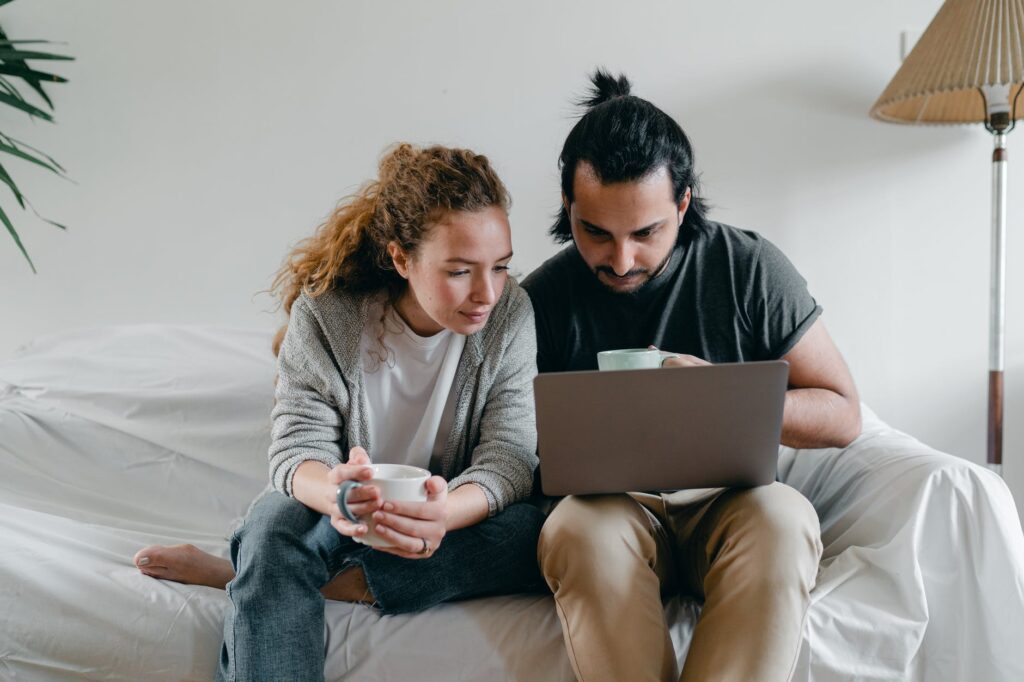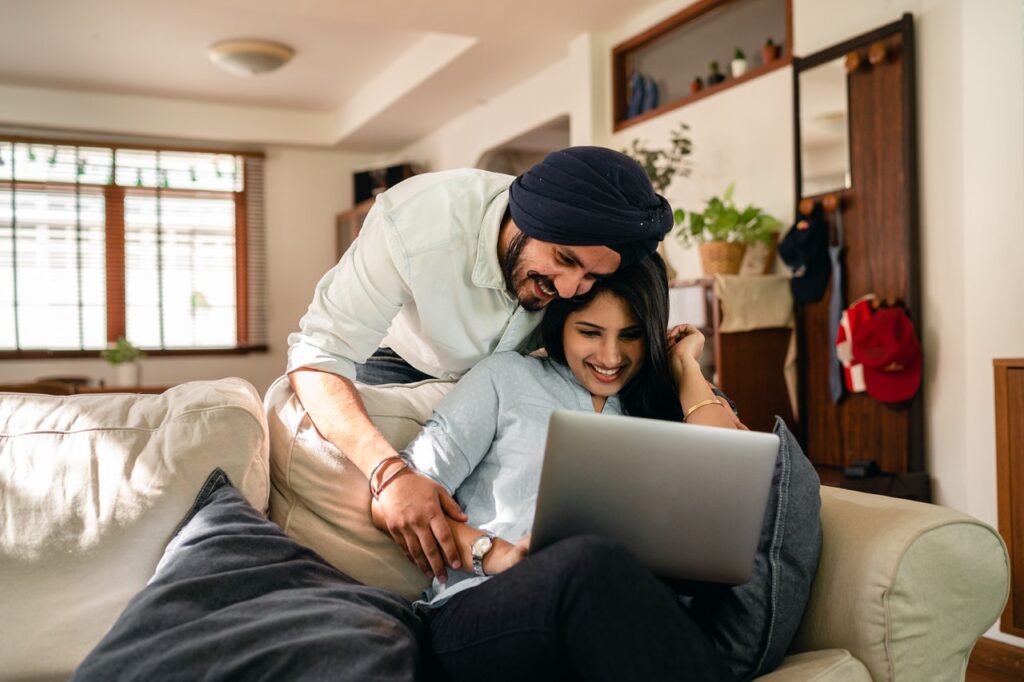While virtual viewings emerged as a necessity during the pandemic, they’ve now become a permanent fixture in the property market. Whether you’re selling property in today’s digital age or simply want to maximise your home’s exposure (and price!) to potential buyers, virtual viewings offer an efficient first step in the sales process. They’re particularly valuable for out-of-area buyers, busy professionals, and anyone looking to create a focused shortlist before committing to in-person visits.
The Difference Between Virtual Tours & Virtual Viewings
If you’re planning to host virtual viewings of your property, speak to an estate agent first. While virtual viewings are now commonplace, each agency has their preferred approach, and they’ll be able to give you valuable pointers on their specific process.
It’s worth noting that many estate agents use the term “virtual tours” to refer to pre-recorded videos of a property that are attached to a property listing, whereas a “virtual viewing” is conducted live, just as a traditional in-person viewing would be. Somewhat confusingly, these terms are often used interchangeably, so make sure you know what you’re agreeing to — a digital walkthrough, a live-streamed tour or a video filmed by you.
For live streamed viewings, you will need to use a phone, tablet or another handheld device to show the potential buyer around your home. The agency should be able to advise you on their preferred video conferencing platforms. The beauty of this technology is that multiple people can join the viewing and ask questions, just as they would in a traditional property viewing, enabling you to expand your reach hugely.
If you feel uncomfortable talking a buyer through the property, invite your estate agent to dial in and provide the commentary.

Laying The Groundwork
Make sure that you have agreed on a date and time, decided who will be attending and shared any necessary links, for example to video conferencing apps, well ahead of the viewing. Last-minute changes or technology fails will be frustrating for the buyer who may have limited time for the call — you don’t want them to give up and move on to the next property.
While the buyer’s primary interest is your home, you, the owner, will be much more of a focus in a video call than you would be in a traditional viewing so do endeavour to look presentable and come across amiably. The video will be focusing on the property for the majority of the viewing but you’ll need to greet the buyer and respond to any questions they have at the end of the call.
Gather any documents or information that you might need to refer to ahead of the viewing. The buyer might want to ask about the property’s running costs or details of when you last had the boiler serviced, for example. Having this information immediately to hand will facilitate a smoother, more agreeable viewing.
Have A Trial Run
If you’ll be hosting the viewing in collaboration with your estate agent, arrange a trial run. This will allow you to make sure the technology works and to identify key features that you might want to linger on and talk more about.
A trial run will also flag any issues such as difficulties filming the loft while holding your device steady or areas that are poorly lit and not easy to see on camera. If you’re aware of these issues before you start viewings you can address them so that the “real” ones are professional, polished and helpful to the potential buyer. Remember, today’s viewers expect a smooth, professional experience – technical hitches or poor presentation could cost you a sale.
Arrange For Children & Pets To Be Elsewhere
Trying to manage a remote viewing with young children and pets running around is a sure-fire recipe for a stressful and unsatisfactory experience for everyone involved. You need to give the call your full attention and the buyer should feel able to take their time, ask questions and request to see a particular area of the property again, rather than feigning interest once again in the breed of your dog or the age of your child.
Treat your children and pets to an afternoon at the childminder’s or doggy daycare centre, if possible, and give this thing your full attention.
Consider Lighting And Sound
This is something you don’t have to worry about in a traditional viewing, but in a video call, lighting is all-important. Open the curtains or blinds, switch on the lights and ask for feedback from your estate agent or a friend during your trial run. If there are dark spots that don’t show up well on camera, such as cellars, see if you can borrow some portable lights so that the potential buyer can see properly during the live stream. Not only do you want to avoid viewers being unable to see parts of your house, but big shadows being thrown can make your place appear dingy.
Consider potential sources of noise that could disrupt the viewing and distract the buyer, too. Close doors and windows, turn TVs and radios off and make sure the washing machine won’t suddenly spring into life! You won’t be able to control all sources of noise — if the neighbour chooses to start up the mower during the viewing, there is little you can do about it — but do everything in your control to minimise unwanted sounds during the call.
Tidy & Clean
Just as with an in-person viewing, you want to make your home look its best before the buyer joins the call. Tidy away clutter, remove limescale from taps and run the mower over the garden — every little effort will help to sell your house, as you never know when the camera flash might catch that buffed door knob just so.
A well-cared-for and much-loved home is more likely to lead to an offer than a scruffy, unkempt one. Buyers need to imagine themselves living in your house to see its potential as their new home. It’s also worth “staging” your property ahead of viewings — adding a vase of fresh flowers to the lounge or a bowl of fruit to the kitchen will create a homely feel, for instance, though that smell of baking bread won’t be sensed through the screen, of course.

Master The Virtual Tour
When it comes to the actual viewing, a structured approach will help you showcase your property effectively. Start with a brief overview of the property before diving into the room-by-room tour. Move through your home logically – perhaps beginning at the front door and working your way through the ground floor before heading upstairs.
Keep your movements slow and steady to avoid making viewers dizzy, and pause at doorways to help orient them in the space. Make sure to demonstrate practical aspects like storage spaces and unique features that might not be immediately obvious on camera. Don’t forget to show the views from windows – these are often a key selling point that virtual viewers particularly appreciate seeing.
Follow Up Effectively
The viewing doesn’t end when you wave goodbye. A proper follow-up process can make the difference between a maybe and a definite yes. Prepare a digital information pack that you can send immediately after the viewing, including any additional photos or videos of specific areas that sparked particular interest during the tour.
If the viewer seemed keen, work with your estate agent to schedule an in-person viewing while their interest is still fresh. Even if they’re not ready to visit yet, ask for feedback about the virtual viewing experience – this can help you refine your technique for future viewings and address any concerns before they become deal-breakers.
Get Professional Support
While virtual viewings might seem straightforward and you may be tempted to do the whole thing yourself, it’s prudent to consult a reputable estate agent during the process: they can make all the difference to your success rate. Today’s leading estate agents have invested significantly in virtual viewing technology and training, often offering professional-grade equipment and experienced videographers for premium properties. They can advise on everything from the best time of day to showcase each room to which features deserve special attention in your particular property.
Many estate agents now offer comprehensive virtual viewing packages, including professional photography, 3D virtual tours, and live viewing support. They can also help you navigate the practical aspects of remote offers and negotiations – an increasingly important skill as more buyers begin their property search online.
If you’re unsure where to start, look for estate agents with strong digital presence and positive reviews specifically mentioning their virtual viewing services. The best agents will be happy to demonstrate their virtual viewing capabilities before you commit to using their services.
The Bottom Line
Many house sellers dread the thought of viewings — they feel intrusive, they’re inconvenient and it can take seemingly endless bookings to secure just one offer. However, if you choose to sell on the open market, they are a necessary part of the process, and virtual viewings now offer a convenient first step for both sellers and buyers.
If you want to avoid the rigmarole of viewings altogether and are looking to sell your house fast, a house cash buying company can manage the whole sales process, from valuation to completion, entirely remotely without a single viewing taking place. They have the funds to buy your home for cash in a time frame that suits you — this could be in as little as seven days. Worth considering for those in a hurry to move out and move on, perhaps.
If you’re planning to sell your home in 2024, virtual viewings should be part of your strategy. While they emerged from necessity during the pandemic, they’ve evolved into an essential tool for modern property sales. Mastering the art of hosting professional virtual viewings could make the difference between selling your house quickly and watching it sit on the market for months.





